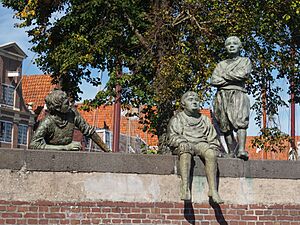Java Ho! facts for kids

Java Ho!: The Adventures of Three Boys Amid Fire, Storm and Shipwreck is an exciting adventure novel. It was written by the Dutch author Johan Fabricius and first came out in 1924. The book's original Dutch title is De Scheepsjongens van Bontekoe, which means "The Shipboys of Bontekoe".
This popular story was even made into a movie in 2007. The book takes ideas from the real-life travel journal of a Dutch captain named Willem Bontekoe. His journal was first published in 1646. The novel follows the thrilling journey of three young boys: Hajo, Ralf, and Padde. They sail to the Dutch East Indies (which is now Indonesia) on a ship called the Nieuw Hoorn. An accident caused by Padde leads to the ship being wrecked. This leaves the boys to survive on their own far from home.
Contents
The Story's Inspiration
The exciting story written by Johan Fabricius was based on a real logbook. This logbook belonged to a 17th-century captain named Willem Bontekoe. He was born in Hoorn, Netherlands, in 1587. His journal described his long journey to the Dutch East Indies between 1618 and 1625.
A Real-Life Shipwreck
During Captain Bontekoe's actual trip, a terrible accident happened. One of his crew members accidentally dropped a lit candle into a barrel of brandy. This started a big fire on the ship. The fire eventually reached the gunpowder storage, causing a huge explosion! Fifty-five sailors, including Captain Bontekoe himself, managed to survive. They reached a place called Batavia (now Jakarta). Captain Bontekoe eventually made it back home to Hoorn. He even faced another near-shipwreck on his way back through China. After returning, he never left Hoorn again. His detailed journal became a very popular book.
How the Book Was Created
Johan Fabricius learned about Captain Bontekoe's amazing journal from his father, Jan Fabricius. His father was also a writer. Johan then decided to add the three young heroes—Hajo, Ralf, and Padde—to this real-life adventure. This made the historical journey into a thrilling story for young readers.
The Adventure Begins
The story starts with Peter Hajo and Padde Kelemeijn. They are two poor fourteen-year-old boys living in Hoorn. They become friends with Rolf, who is the nephew of Captain Willem Bontekoe. Hajo's father was a fisherman who sadly drowned. Hajo works as a blacksmith's helper, but he dreams of sailing the seas.
Joining the Crew
Hajo decides to sign up to sail with Captain Bontekoe to the East. Rolf also joins the crew. The ship sets sail from Texel, an island in the Netherlands. Padde comes along to say goodbye to his friends. But he misses the ship that would take him home! So, Padde also becomes a sailor. He works as an apprentice helping with the ship's food and drinks.
Disaster at Sea
Off the coast of Sumatra, a big island, Padde accidentally knocks over a candle. This starts a fire on the ship. The fire quickly spreads, and the ship explodes! The survivors manage to reach the coast. However, they are met by local people. The three boys, Hajo, Rolf, and Padde, along with another sailor named Harmen, decide to try and reach the Dutch colony of Batavia.
New Paths
Once they arrive in Batavia, their paths separate. Rolf stays in Asia with his uncle, Captain Bontekoe. The other three boys, Hajo, Padde, and Harmen, sail back home to the Netherlands. They return with gifts and a bag full of money they earned. They are reunited with their mothers and siblings, full of incredible stories from their journey.
The Book's Lasting Impact
Even though sales were slow at first, Java Ho! became Johan Fabricius's most famous book. Between 1924 and 1996, the book was printed 21 times. It sold an amazing 250,000 copies! It was also the first children's book ever published by the company Leopold. An English version was published with the title Java Ho! The Adventures of Four Boys Amid Fire, Storm, and Shipwreck.
Statues and Adaptations
In the city of Hoorn, where the story begins, you can find statues of the three boys. These statues were made by Jan van Druten in 1968. They stand on the quay, looking out towards the sea, just like the boys might have done. The book has also been adapted into other forms. A television reading by Coen Flinck aired in the 1970s. The movie version premiered in November 2007. A comic book version, with drawings by Piet Wijn and text by Frans Jacobs, was released in 1996.
Changes in English Version
Some changes were made to the English version of the book compared to the original Dutch one. Certain parts that might have been seen as too violent were removed. For example, a chapter where the sailors had difficulties in a Chinese restaurant in Batavia was changed.

